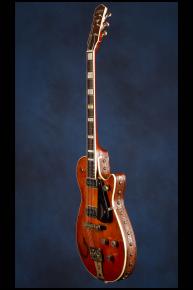An Excellent Late 1954 Gretsch 6130 Round Up
1954 Gretsch Round UpThis Late 1954 (third batch of Round-Ups), 13 1/2-inch-wide semi-solid body 'cowboy' guitar weighs just 7.30 lbs. Chambered mahogany body with the "G" branded into the front and with studded leather tooled with Western motifs around the sides. One-piece mahogany neck with a nice wide nut width of just under 1 3/4 inches, a scale length of 24 1/2 inches and a very fast thin-to-medium neck profile. Bound rosewood fretboard*** with 22 thin frets and inlaid pearl block markers with 'Steers-Head' & 'Cactus' and small red dot side markers. Headstock with walnut veneer and inlaid pearl Gretsch "T-roof" logo and steers head inlay. Individual Grover StaTite open-back tuners with oval metal buttons. Two single-coil DeArmond 'Dynasonic' pickups, with outputs of 2.90k, and 2.75k. Original tortoiseshell pickguard with engraved steer's head secured to body by side-bracket and two screws. Four controls (master tone and two individual volume controls on lower treble bout, one master volume control on cutaway bout) and one three-way selector switch on upper bass bout. Brass control knobs with cross-hatch pattern on sides and 'arrow' but no 'G' on top. Melita Synchro-Sonic bridge and G-hole flat tailpiece with Western-style belt buckle covering the string anchors. All hardware gold-plated. Serial number "13967" stamped on Gretsch label inside control cavity and also etched on the outside of control cavity cover. There are a few small and insignificant surface marks but this is certainly one of the cleanest early Round Up's that we have ever seen (***see note below). This sixty-seven year old piece of western history is in excellent plus (8.75) condition. Complete with the original 'western-tooled' and 'bejeweled' brown brown leather guitar strap, the original "Gretsch Guarantee" envelope and an original set of "Gretsch Electromatic" (flat-wound) guitar strings in their original clear plastic 'drum' container. Housed in the original Gretsch four-latch straw-colored fitted case with burgundy plush lining and white silk banner with "Gretsch" in blue on inside of case-top (9.00).
*** The rosewood fretboard and frets have been expertly replaced with a later identical fretboard and identical frets - most probably by the Gretsch Custom Shop in Corona, CA. This of course has been reflected in the price.
"In 1953, the Gretsch factory produced its first batch of what would become the company’s premier solidbody guitar, the Duo Jet model 6128. This model was destined to be spun-off into several other Jet variations. On the heels of that debut batch of Duo Jets was a group of 50 guitars, designated as the Round-Up model (6130). These were an unapologetic assault on the Country & Western musician community. Although many of the western aesthetic devices found on the Round-Up were soon adapted to other Gretsch models, the model 6130 was where it all originated.
Retaining all the common structural specifications of the Duo Jet, the Round-Up has a 13.5-inch wide, chambered body, and employs dual-DeArmond Dynasonic pickups, a highly adjustable Melita bridge, rosewood fretboard, and open-back Waverly tuning machines. The model 6130, however, isn’t nearly as subtle in its visual presentation. All the hardware is gold-plated, the guitar’s top is usually made of pine stained to a dark transparent orange, which allows any knot-holes and/or grain patterns to show through. A large “G”-brand is positioned on the lower bass bout. The static tailpiece is a variation on the standard G-cutout tailpiece, adopting a belt-buckle accessory depicting cowboys and covered wagons. The celluloid tortoise shell wedge-style pickguard possesses and etched image of a steer-head, which coordinates with a similar graphic inlaid into the headstock. The block style fretboard markers are also etched with western motifs (cows and cactus), and the sides of the guitar are adorned with a tooled leather and studded band depicting similar motifs.
The debut batch of Round-Up’s [50] guitars) was manufactured in 1953 (#12100-12150) and can be identified by the missing inlay at the first fret. They have plain-topped control knobs, and many are prone to possessing knots on their pine tops. Two subsequent batches were produced for the 1954 model year (#131XX) and (#139XX), each batch being 50 guitars), differentiated only by their block marker at the first fret. For the 1955 model year another three batches of 50 guitars each (#139XX), (#152XX) and (#167XX) were produced.
Arrow-topped control knobs quietly announced the ’55 model year guitars, but after only a third batch at #167XX, the model was abruptly dropped. This (apparent) discontinuation of the Round-Up was no doubt a result of the redundancy created by the debut of the very similar Chet Atkins signature model 6121 Solidbody at batch #165XX.
Then, in the 1957 model year, inexplicably a single group of 50 Round-Up model 6130 guitars was produced at batch #234XX. These guitars lacked the G-brand and had a horseshoe headstock inlay. The earliest of these maintained the hump-block fretboard markers (first seen in late #167XX examples) and Dynasonic pickups. A few of the later examples are apparently some of the very first Gretsch guitars to receive the neoclassic fretboard markers, the tone switch feature, and Filter’Tron pickups.
With only a handful of batches manufactured, a total of about 400 Round-Up model guitars were produced, making them a rare and coveted Gretsch model today." (Ed Ball. Manual of Gretsch Guitars - 1950s. p. 71)



























